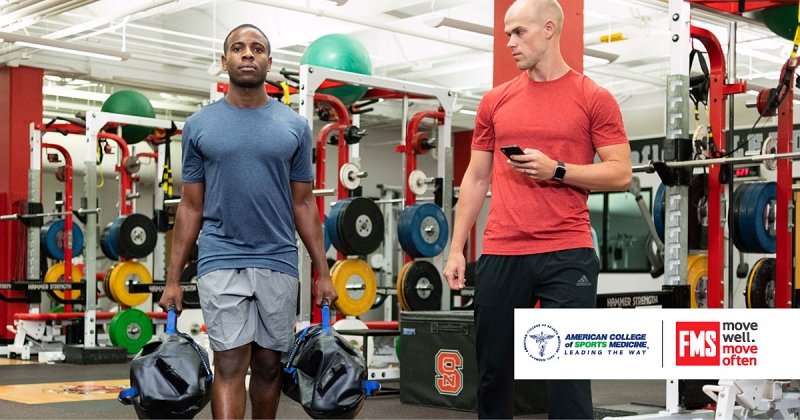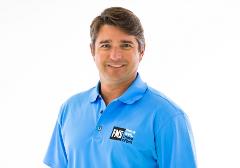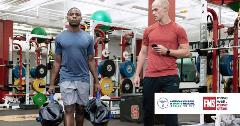Lee Burton, Ph.D., ATC |
Nov.
21, 2019

Functional Movement Systems (FMS) and ACSM recently hosted an industry-presented webinar with Lee Burton, PhD, ATC, entitled Secrets to Enhancing Shoulder Strength and Function. This is Part I of the Q&A.
Read Part II of the Q&A here.
Several questions were asked by attendees during the webinar and the answers pertaining to instability, dysfunction, and more are below.
Q: What's your go-to exercise/stretch for shoulder health for any client and why?
The initial focus should be to improve thoracic/mid-back mobility instead of stretching the shoulder. A lack of mobility in this area commonly leads to problems in the shoulder. A side-lying rotation can be a good activity, lying on your side with the top leg pulled toward your belly, placing the knee on the ground. From there grab your ribs with your top hand between the ground and ribs and pull your ribs and torso around creating rotation. Do this without allowing your top knee to come off the ground.
Q: Are there any assessments that exist that will help detect weak areas in the upper body?
Initially it is best to perform tests/screens that will give you an overall idea of weakness in the upper body and not try to pinpoint a specific area/muscle. Performing an extended or flexed arm hang for time as well as grip strength testing will give you a good gauge of upper body strength. There is plenty of research data that can be accessed on the internet which should give you an idea of normative values to compare. In our system we look at the push-up and upper body motor control, which is a single arm plank with a reach, we have found these tests to be useful since they also give us some information on core stability.
Q: In your opinion what is the best exercise to stabilize the shoulder blades?
Based on the concept of regional interdependence it is best to understand or determine what is causing the instability in the shoulder blades. Many times, the instability in the shoulder blades can be caused by a lack of mobility in the mid-back so improving mobility here will help with overall shoulder blade stability. You first need to ensure you have good postural control so performing farmer’s walks for time with good postural integrity is a good activity as well as push-ups with a focus placed on the press at the top to create scapulae protraction.
Q: Would you avoid recommending shoulder exercises such as the overhead press in a client with a mild thoracic scoliosis?
If you are prescribing good mobility activities to help with the scoliosis, then performing forward or horizontal presses would be a good start. Standing or half-kneeling with one-arm forward presses would be good to also improve core stability and allow you to focus on the weaker side. One-arm overhead presses would be more beneficial for the same reason if the client can maintain good posture integrity while going overhead. A Turkish get-up is also an option to work them into good posture and getting the arm overhead.
Q: Does that mean that if someone has a shoulder dysfunction it could affect one's breathing?
Yes, the data suggest that poor shoulder mobility and breathing are related. This is mainly because of the way we typically test shoulder mobility, which is many times created by a lack of mid-back mobility, rounded shoulders, etc.
Q: How specifically does grip strength associate with upper and lower body strength? Wouldn’t a rock climber or power lifter have stronger grip by their sport-specific demand whereas grip is less of a factor in say basketball?
There is a lot of research data that suggest that grip strength is related to overall strength. This, in my opinion, relates more to activity level.
Q: Exercise professionals (e.g., personal trainers) are not licensed health care providers (e.g., physical therapists, chiropractors, medical doctors). Certainly, exercise has therapeutic benefits and exercise is medicine. Where do you draw the line with regard to scope of practice for exercise professionals and corrective treatment and when working with clients who are experiencing pain and musculoskeletal dysfunction?
Great questions and ones we all as professionals need to work together in order to create a more clear idea of where the line is and how we can all help each other. In my opinion, if a person is currently experiencing pain they should at least have a medical diagnosis. They can certainly exercise if they are having pain; however, there are certainly some activities that should be avoided which the medical professional could/should provide. Since this is such a difficult thing to clearly define the best advice is to create some lines of communication between the exercise and medical professionals.
Q: What's happening in the body, and how do we fix it when there is significant forward flexion in the upper body (not necessarily in the spine, but at the hips) while squatting?
There could be many problems. It is difficult to point to one thing without having other movements to view. The reason we look at seven patterns is exactly for this reason. We need to have an overall profile of different movements in order to make a better recommendation.
Q: Would FMS assessments be recommended for use with obese populations?
Yes, however, start with the easier movements such as the shoulder, leg raise, and don’t make too many assumptions as to what the person can/can’t do. The idea is to simply set a baseline of what can and can’t be done. If none of the movements can be performed that is OK. You can then shift to improving fundamental mobility and body weight activities and then go back and recheck the patient.
Q: Fascinating information. What would you recommend for a person with slightly left scoliosis with a flat and tight thoracic spine? Also, this person can’t do any overhead movements without pain that also occurs in the base of neck.
Start on the ground with crawling, quadruped rotations, etc. focus on the tighter side. Working toward Turkish Get-ups which will have the body work itself under the arm which is a great way to get the arm overhead.
Q: Do you think there is ever a scenario where actively training external/internal rotation, for example, is necessary? As opposed to just stability/anti-rotation, such as in the realm of physical therapy.
I don’t believe it is necessary unless there is a medical problem with the shoulder/rotator cuff. Focus more on stability activities such as deadlifts and farmer’s walks which are better activities for stability.
Q: What about exercises such as Ts and Xs to improve posture?
These would be good supplemental activities.
Q: A group fitness setting presents its own unique challenges as individuals come and go often without regularity. How would you approach individuals with poor movement skills in a group fitness setting and address these poor movement qualities?
This is a difficult situation; however, ideally you could try and perform some type of screening or assessment prior to beginning the group fitness session. My best recommendation is to at least keep an eye on individuals who breakdown during the session and try giving them some ideas of alternatives or things they can do on their own.
Q: So, what were the "secrets of shoulder function?" It seemed like just a brief and vague FMS description.
Grasping an understanding of regional interdependence, knowing that shoulder function is directly dependent upon other areas of the body working correctly. Before you start shoulder activities ensure that they have good mobility in the mid-back/T-spine, check breathing and work on stability through push-ups, quadruped activities and deadlifts.
Q: In your experience, how long does it take to improve an individual's trunk stability push-up? When is it more "strength" than stability/motor control?
This is really dependent upon the age, behavior and activity level of the individual. What other aspects of their lifestyle could/should be considered? If it is truly a strength problem, then most data say 4 to 6 weeks of strength training to have strength gains.
Presenter:

Dr. Lee Burton has an extensive background in sports medicine and strength and conditioning. He currently consults with a wide variety of professional sports organizations as well as leading health and fitness facilities on injury prevention and performance enhancement. He lectures both nationally and internationally on various topics in the fields of sports medicine and strength and conditioning. Dr. Burton is a Certified Athletic Trainer, Certified Strength and Conditioning Specialist and one of the founding owners of Functional Movement Systems.
View More Popular FMS Content

CEC Course | FMS - Move Well then Move Often

Secrets to Enhancing Shoulder Strength and Function Q&A Part I